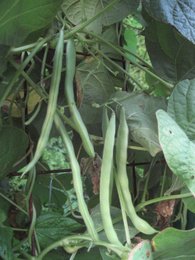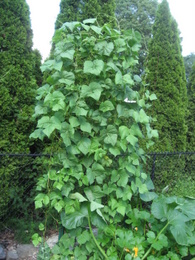Bean Growing Guide
Beans (Phaseolus vulgaris) are annuals and are very popular with gardeners because they require very little care and are very productive. All you need to do is provide a nice sunny location and decide what kind you want to grow.
Beans can be produced on bushy plants or on vines. The bush and vining types can be the shelling or the edible podded varieties.
The bush bean varieties grow to about 2 to 3-feet tall depending on the variety. They tend to be self-supporting when planted close together and do not need a trellis, but a stake or some form of support will help keep them from falling over.
The tall vining varieties also called pole beans should be planted on the north side of your garden so they can take advantage of the sunlight and will not shade other lower plants in your garden. This is also true for peas and corn which should be planted at the north side as well. You can adjust the location a bit because during the summer the sun is at a much higher angle and is almost overhead at noon.
Look at the seed package carefully before planting to determine if it is a vining variety that needs to be planted on a pole or along a fence or a trellis.
In the past they were called string beans due to the stringy pod. Almost all varieties today are stringless and are called snap beans, because when you bend the pod it will snap in two. Sometimes they are also called green beans or garden beans. These are completely edible, pod and all.
Soil Preparation
Beans will grow best in good loose organic garden soil with the soil pH between 6.0 to 6.8. As soon as the soil is frost-free and can be worked, till the soil by digging down 8 to 12-inches turning the soil over with a garden fork. Remove any large rocks and stones. The small stones remaining will do no harm and actually benefit the soil by adding some micronutrients to the soil.
Planting
Beans and peas are in the legume family and have the ability of fixing nitrogen in the soil. If you have never grown them in the area where you are going to plant them it is helpful to inoculate them with rhizobium bacteria before planting them. This will often help increase yields. It can be found in garden centers.
Plant beans in full sun directly in the garden after all danger of frost. For bush or dwarf varieties plant the seeds 1 to 2-inches deep, 3 to 5-inches apart in rows 2-feet apart. Thin as needed, but allowing them to crowd each other a bit will keep the weeds down and help support each other. You can give them some support with some short stakes.
The vining pole varieties can reach 6 to 10-feet in height and will need something to support them. Tying 3-poles together at the top and pushing the ends into the ground several feet apart like a tripod or tepee is a common method of growing them. A trellis or fence can also be used to support them when they are a few inches tall. Water them deeply once a week to keep the shallow roots from drying out in particular when the plants are flowering and producing pods.
You might want to try the Native American method of growing corn, beans and squash together called the Three Sisters.
For more detailed information visit the seed starting page.
Mulching
When they are a few inches tall a nice loose mulch of shredded leaves or pine straw will help shade the roots. This will keep the weeds out, the soil cooler and keep the soil moist.
Harvesting
Beans are best picked when the pod is full-sized, but before the beans are showing through. When the pod takes on the lumpy look you can still eat them, but they will not be as tender and tasty.
They are shallow rooted and can be easily be pulled out of the ground. Use one hand to hold the pod and the other to hold the vine. Scissors or snips will help you harvest very quickly. Check your beans often as soon as the pods appear. The green beans can be picked at any time.
The shelling beans can stay on longer since you want the beans within the pod to develop fully. Pick these when the pod is well filled and starts to turn brown. They should dry on the vine and be loose inside the pod. Pick the dry pods and remove the beans. The pods can be spread out on a cookie sheets to dry more if needed. The shelled beans can then be stored in airtight containers in a cool dry place.
Popular Bean Varieties
Pole Beans: Blue Lake, Emerite, Fortex, Kentucky Blue, Kentucky Wonder, Romano.
Bush Beans: Bush Blue Lake, Charon, Derby, Jade, Provider, Tendercrop.
Yellow Bush Beans: Cherokee Wax, Golden Butterwax, Goldencrop Wax, Golden Rod, Golden Wax, Gold Mine, Gold Rush.
Dry Shelling: Bingo, Black Coco, Black Turtle, Cannellini, Cranberry, Great Northern, Flambo, Pinto, Red Kidney, Soldier, Vermont Cranberry, Yellow Eye.
Sources: Seeds Now, Burpee, Johnny’s Selected Seeds
Garden Spikes newsletters give you timely information once or twice a month. Subscribe Free to the Garden Times newsletter below.
Your email address will only be used to send you a newsletter and will never be sold. You can unsubscribe at any time.


